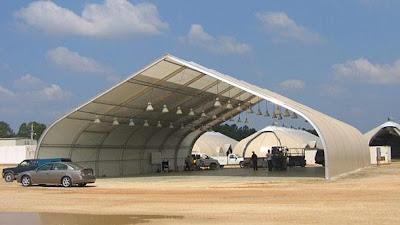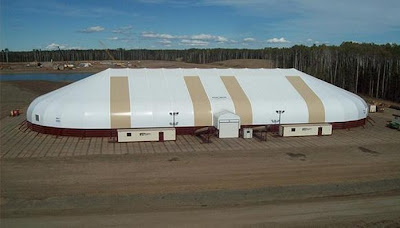
Fabric structures pose many benefits to many business owners, government agencies and to ordinary citizens like you. These structures are very helpful in housing different kinds of valuable goods, open spaces, camp sites, people in the party and many others. What are these fabric structures, by the way?
Fabric structures are the architecturally forms of constructed fibers or fabric made for exclusive housing purposes, may be temporary or permanent. They are easy to build, moved or relocated. They can be placed on the wheels and moved to other place where it will be used as temporary shelter again. They are easy to construct or build. Engineers and construction workers use light-weight materials, specifically, fabrics than meshes and films. The fabrics are coated and laminated with many kinds of synthetic materials to promote durability, strength and environmental resistance.
Fabric structures use the following materials:
- cotton canvas
- vinyl-laminated polyesters
- vinyl-coated polyesters
- polyesters
- fiberglass
- olefin or polyolefin
- blackout fabric
These fabric materials are used to aid easy and fast construction of the building in much lesser costs. Compared to the traditional building materials, fabric structures have one of their kind properties that make them strong, durable and could withstand natural phenomena. The following are the properties of the fabric materials that are very beneficial to the construction of the structure.
Tensile strength – this is what they refer to relative strength. It is very basic to the fabric structures to have function primarily in tension.
Tear strength – this is probably the most important of all. When the fabric collapsed in place, this is because of its tearing condition. The tearing can occur with one yarn and the huge tearing will follow when it is left untreated. This can occur when there is a local concentration of the stress or damage on one yarn leaving others to suffer the same stress causing a huge tear afterward. This solve the primary problem because fabric structures have tear resistance.
Adhesion strength – adhesion is a measure of strength between two connecting bonds. In fabric structures, the connecting bonds are the base material itself and the film coat or lamination that protects the material. They are very useful in evaluating strength of the two connecting bonds, joints or strips.
Flame retardancy – it is different from the word flameproofing. Those fabrics that has flame retardant characteristic can withstand even in the exposure hottest flame source. But it can still burn when exposed huge fire flames.
Because fabric structures use fabric materials, they also help in saving a lot of money in the construction cost. It costs almost half the price of the ordinary construction cost. Aside from that, fabric structures can also withstand even against the raging hurricane or cyclone. The strength and durability of this fabric structures never fail. They meet the expectations of every construction owners, engineers and businessmen. They are very mobile and flexible. They can be folded, disassembles and reassembled. They are very sleek, one of a kind construction breakthrough. It has been in the industry for more than a hundred years now. This proves their importance in the modern engineering technology and even beyond.









The fabric cover has non-conductive properties that reduce the transmission of heat and cold, making the building feel warmer in the winter and cooler in the summer. The translucent properties of the fabric covers allow natural daylight into the building, reducing or eliminating daytime lighting costs, and creating safe environments for workers. Custom fabric buildings feature a high roof design which results in a large volume of interior air space. The fact that fabric structures can be built on portable and temporary foundation systems are really what sets them apart from traditional buildings.
ReplyDeleteSource: Custom Fabric Structures